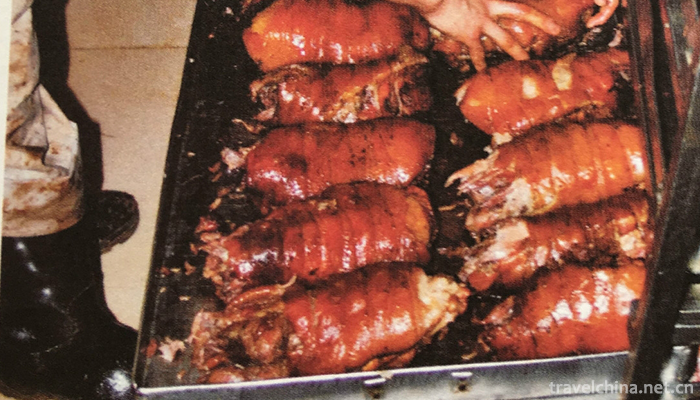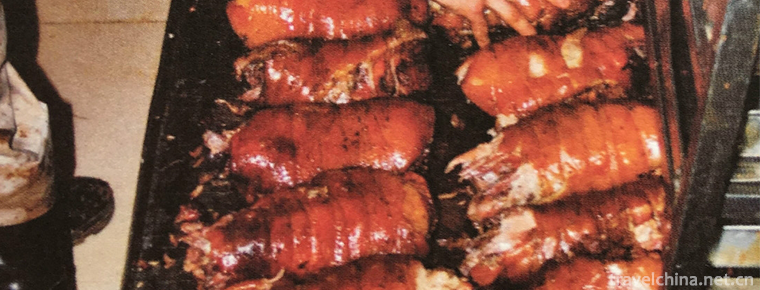Traditional Processing Techniques of Liuweizhai Sauced Meat
Traditional Processing Techniques of Liuweizhai Sauced Meat
Liuweizhai is a well-known Chinese brand which was founded in 1738 in the three years of Qianlong in Qing Dynasty. Its sauced meat, as a traditional food in China and a famous food in the Three Jin Dynasty, was once well-known as a tribute to the imperial palace.
Liuweizhai sauce meat traditional production techniques have been passed down from generation to generation, retaining the characteristics of traditional sauce meat production techniques. It chooses fresh (frozen) pork as raw material, and is processed into blocks by dividing, singing and other processes. After adding a variety of traditional Chinese medicines and condiments, it is made by brine, sauce and brushing. Liuweizhai sauce meat skin is bright, red and purple, fragrance overflowing. Seen from the appearance color as sauce-red or reddish-brown, after cutting with knife, the internal tissue is pink, the taste is rotten and delicious, fat but not greasy, thin but not wood, not only tastes delicious, often eaten, but also has the effect of health preservation, which really achieves the "medical and food homology". In the traditional craft of Liuweizhai, the sauce brush sauce technique is the embodiment of long-standing experience and inheritance characteristics, and it is the unique craft necessary for sauce meat processing. The sauce is made by boiling the filtered residue of the old soup of the marinated sauce meat. Because there are many processes in the process of making sauced meat, the pigskin is soft and tender after brine and sauce, and the appearance is not very good. Brushing juice is to protect pigskin, make the appearance beautiful, and improve the taste. The characteristics of "cooked but not rotten, sweet but not strong, salty but not astringent, bitter but not strong, light but not thin, fragrant but not tired, fat but not greasy, thin but not firewood" of Liuweizhai sauce meat embody the Chinese food culture of "harmony is the beauty".


-
1.Almond dew
Almond is a kind of vegetable protein beverage made from natural almond and mineral water. Its white like milk, delicate like jade, unique flavor, can be used as a substitute for ordinary milk
Time 2018-11-08 -
2.Hu Ji Shu Hui
Hu Jishu Fair is a traditional folk art fair that rose and took root in Huji Town, Huimin County, Shandong Province. Huji is the largest market town in the southeast of Huimin County
Time 2019-05-03 -
3.Huizhou three carving
The three carvings in Huizhou are a kind of local traditional carving art. They refer to three kinds of local traditional carving crafts, i.e. wood carving, stone carving and brick carving,
Time 2019-05-04 -
4.Falling cavity Luoqiang
Luoqiang is a traditional opera in Neihuang County, Anyang, Henan Province. It was originally called Luoziqiang, also known as Anyang Qiang. It is mainly prevalent in the Zhanghe River Basin in the no
Time 2019-05-15 -
5.Back to back entanglement
Tongbei Bianquan, also known as Hongdong Tongbeiquan, is a complete and systematic set of traditional boxing. It combines the advantages of both inside and outside. It is divided into mother boxing an
Time 2019-06-21 -
6.Yangzhou lacquerware decoration skills
Yangzhou lacquerware painting process is cumbersome, the step is "batch putty scrape gray, brush paint and push light". During the Warring States Period, Yangzhou lacquerware decoration tech
Time 2019-07-10 -
7.Legend of Yang Jiajun
The Legend of Yang Jia Jiang is a kind of literature expressed by folk rap in Northwest China. The story of the generals of the Yangs has a long history. It began to circulate as early as the Song Dyn
Time 2019-07-11 -
8.Beijing Sport Univerrsity
Beijing Sports University was founded in 1953, formerly known as the Central College of Physical Education, renamed Beijing Sports College in 1956 and Beijing Sports University in 1993. It is a nation
Time 2019-09-06 -
9.Anhui University Of Technology
Anhui University of Technology is located in Anhui province. Ma'anshan The city is a multi-disciplinary university characterized by industry and industry. Ministry of science and technology With the s
Time 2019-10-10 -
10.The position of Panzhihua
Panzhihua City is located at the junction of Sichuan and Yunnan in Southwest China, 26 ° 05 ′ - 27 ° 21 ′ N and 101 ° 08 ′ - 102 ° 15 ′ E. Jinsha River and Yalong River meet here. It borders Huili, Dechang and Yanyuan counties of Liangshan Yi Autonomous Prefecture
Time 2020-12-14 -
11.Suining economic development
In 2019, Suining's GDP will reach 134.573 billion yuan, an increase of 8.1% over the previous year (the same below) at comparable prices. Among them, the added value of the primary industry was 18.521 billion yuan, an increase of 2.7%; the added value of the
Time 2020-12-16 -
12.Meishan City logo
Meishan City logo is composed of ancient Chinese tile pattern and Dongpo head portrait, which shows a feeling of ancient historical traces and reflects the ancient culture of Meishan. From the design to the font are used a simple style, using the combinatio
Time 2020-12-18